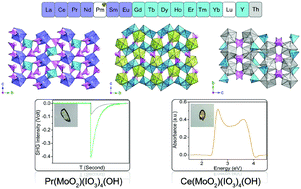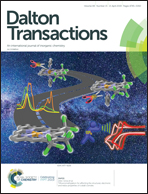Expansion of the structural diversity of f-element bearing molybdate iodates: synthesis, structures, and optical properties†
Abstract
Expanding the family of f-element bearing molybdate iodates via hydrothermal reactions has yielded ten new rare-earth molybdate iodates with two distinct phases, Ln(MoO2)(IO3)4(OH) (LnMoIO-1, Ln = Ce and Pr) and Ln(Mo2O7)(IO3)(H2O)2 (LnMoIO-2, Ln = Gd–Yb, and Y), as well as the first thorium molybdate iodate, ThF(MO4)(IO3) (ThFMoIO). All three structures exhibit three dimensional frameworks and are exclusively built from lanthanide/actinide polyhedra bridged by molybdates and iodates. Furthermore, the coordination versatility of molybdates (octahedral, square pyramidal, and tetrahedral geometries) results in a diversity of structures. The effect of the lanthanide contraction on the compositions and structures is clearly observed, showing the increase in hydration from the early to late lanthanide analogues and the decrease in unit cell dimensions and the average Ln–O bonding distances across the same structure type. Single crystal X-ray diffraction studies reveal that LnMoIO-1 (Ln = Ce and Pr) crystalize in a noncentrosymmetric space group P21 and the second-harmonic generation (SHG) measurement shows a response of 5 × KDP for PrMoIO-1. In addition, CeMoIO-1 crystallizes as orange coloured tablets which are semiconducting in nature with a band gap of 2.41 eV.



 Please wait while we load your content...
Please wait while we load your content...